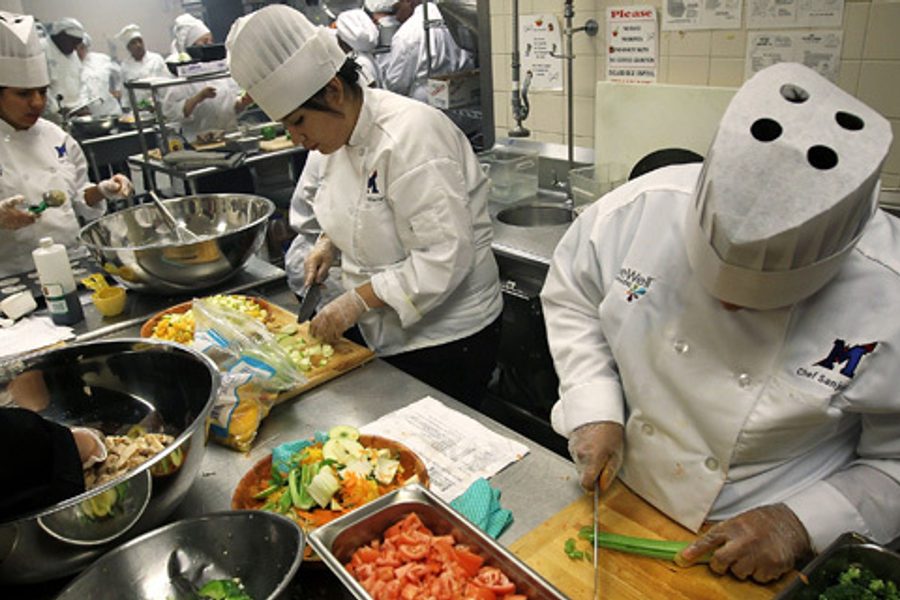
A widespread lack of living wages, access to benefits and protection by standard labor law are plaguing the food sector industry, according to a comprehensive study released today by the Food Chain Workers’ Alliance, which examined working conditions and wages for industry employees.
The study, “The Hands That Feed Us: Challenges and Opportunities for Workers Along the Food Chain,” sampled from 20 million food industry workers from the five major areas of the food industry — production (farmworkers), processing (slaughterhouse workers), distribution (warehouse workers), retail (grocery store workers) and service (restaurant workers). It found that only 13.5 percent of all workers receive a living wage; 86 percent of workers reported receiving poverty-level wages.
Food Chain Workers’ Alliance, founded in 2009, is a “coalition of worker-based organizations whose members plant, harvest, process, pack, transport, prepare, serve, and sell food, organizing to improve wages and working conditions for all workers along the food chain,” according to their website.
As an industry, the food sector employs more than any other industry in the U.S. — one out of every five workers in the private sector, or around 17 percent of working Americans, according to the FCWA report. Annually, the food industry sells $1.8 trillion in goods and services and accounts for 13 percent of the country’s gross domestic product, the report said.
The study also found food-sector workers are, ironically, twice as likely to receive food stamps, confront a food shortage in their daily lives, and experience dependence on other government-provided services like Medicaid and energy assistance.
“Food workers face higher levels of food insecurity, or the inability to afford to eat, than the rest of the U.S. workforce,” the report stated. “In fact, food system workers use food stamps at double the rate of the rest of the U.S. workforce. They also reported working in environments with health and safety violations, long work hours with few breaks, and lack of access to health benefits.”
Along with examining food-sector workers’ dependence on government assistance and wages, the report examined working conditions and found that food-sector workers face high levels of wage theft, little opportunity for mobility, deficient access to benefits like health insurance, and a high chance of injury on the job.
Eighty-one percent of workers in the food sector never received a promotion in their job, and 79 percent did not have sick days, according to the report. Fifty-eight percent were not covered by any type of health insurance, despite the fact that 57 percent of the surveyed workers reported having suffered an injury on their job site. “Most employers agreed that providing better wages, working conditions, and advancement opportunities decreases worker turnover and increases productivity,” the report stated. “However, many admitted to not actually engaging in these practices.”
The report also found that 36 percent of surveyed workers experienced wage theft in the week prior to the survey. The average weekly wage theft totaled around $35, according to the report.
“Due to a lack of sick days provided by employers, more than half (53 percent) of the workers surveyed reported picking, processing, selling, cooking and serving food while sick, an average of at least three days per year. Due to a lack of employer-provided health benefits, more than one third of all workers surveyed (34.8 percent) report using the emergency room for primary health care. In addition, 80 percent of these workers are unable to pay for such care.”
The report suggested solutions to abate the poor food-sector conditions: (1) Raise the living wage, including for employees who work for tips; (2) increase penalties for food system employers who engage in exploitation, including wage theft, especially through regulatory levers like liquor licenses; and (3) guarantee food-sector workers the right to organize and to be protected against retaliation for organizing.
“Most employers agreed that providing better wages, working conditions, and advancement opportunities decreases worker turnover and increase productivity. However, many admitted to not actually engaging in these practices. Nevertheless, the fact that employers agree in principle indicates that there is potential for industry change, and potential demand from employers for greater tools, incentives, and training to improve wages and working conditions in the food system.”





